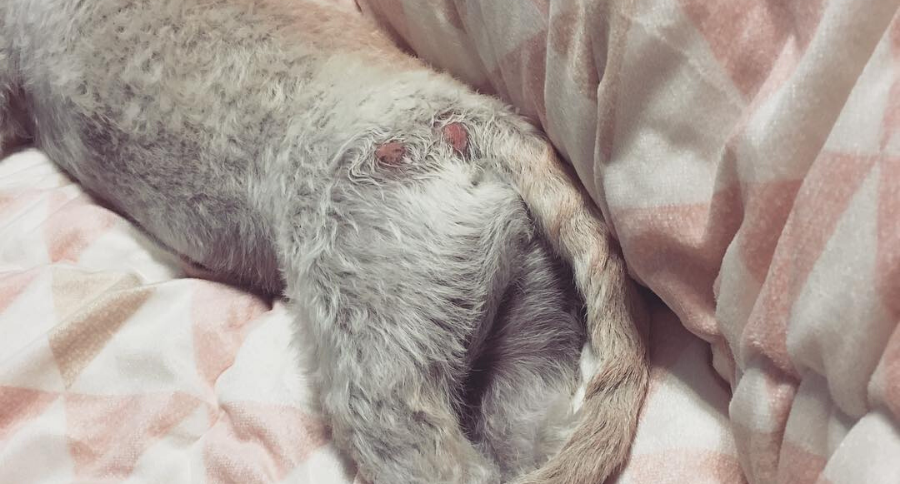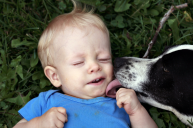What are those red circles on my dog? That's what I asked my vet when Walter, our doxie, spent a weekend digging at the beach and then had these suspicious-looking circles on his belly. He was still a puppy and I was horrified! There were patchy areas of hair loss and I was convinced it was ringworm. Unfortunately, I was spot on.
Ringworm is a very contagious fungal infection that affects most mammals (cats are known to get this too). The common fungal agents that cause dermatophytosis in pets are Microsporum canis, Trichophyton mentagrophytes, and Microsporum gypseum. I've read that ringworm infections in dogs can be quite low and I happen to live in an area and region where it's wet (and humid) all the time and there are many cases of ringworm diagnosed at clinics throughout the Pacific Northwest.
How do dogs get ringworm?
https://www.instagram.com/p/B3mdTUYnS8k/
The Spruce Pets tells us that since the ringworm fungus resides in the soil, a digging dog encounters it regularly.
"However, not all animals will contract the fungus simply from contact. The age of your dog (puppies are more prone to infection), its immune status, and grooming habits all affect the rate of transmission. In both people and dogs, those with suppressed immune systems are most at risk."
Walter was a puppy at the time and we were just finished with his vaccines so this was one of the first trips to the beach!
The vet knew right away as the clinic typically performs diagnostic tests and a physical exam. In Walter's case, they took a sample of his hair for a fungal culture and examined infected hairs under a special ultraviolet light called a Wood's lamp.
It's very common to see scaly areas of hair loss.
How contagious is ringworm?
https://www.instagram.com/p/B16gF25H4CD/
Humans can get ringworm from their pets simply by petting them! It's a zoonotic disease and very contagious. Until Walter was ringworm free we had to use caution and it was a nightmare.
What are the common clinical signs and symptoms?
https://www.instagram.com/p/B0MGBfZFl9q/
Walter had the scaly patches and circular areas of hair loss on his belly but Certa Pet lists symptoms that are most common to least common below. Rough brittle claws are another sign too not listed below.
- Dogs will develop multifocal circular alopecia around their face, feet, and head.
- Folliculitis (inflammation of the hair follicle) and furunculosis (infection of the hair follicle) are common clinical signs of dermatophytosis. Folliculitis can be localized, generalized, or regional.
- Seborrhea sicca and hair loss are common findings
- Papules, scaling, crusts, and pustules may be seen as well
Ringworm doesn't typically itch.
How is ringworm treated?
https://www.instagram.com/p/BN5S2SaAr9g/
A lot of baths with medicated shampoo. We had to wear gloves every time we bathed Walter.
The American Kennel Club (AKC) outlines three steps:
- Topical therapy
- Oral medications
- Environmental decontamination
Oral therapy is used in conjunction with topical therapy like medicated shampoo. You must remove all the hair from any surfaces in the home to ensure it doesn't spread so keeping up with daily cleaning is really important.
Can you prevent it? The answer is directly related to keeping the environment clean. There is no way to prevent it but just knowing what signs to look for and then the steps to immediately take will help! Start cleaning and get to the vet.
Dog owners swear by Curaseb Antifungal & Antibacterial Chlorhexidine Shampoo for Dogs & Cats, which you can find on Amazon in different sizes for under $20.
What should I do next?
Be very transparent with your vet or DVM about whether or not there are young children at home. Ringworm is known to be extremely contagious and in addition to children you need to let them know if any family members at home are immunocompromised. Keeping your environment clean by vacuuming to prevent the spread of infection is one way to ensure ringworm is gone forever!
The symptoms of ringworm outlined in this article are very specific and the patchy and circular areas of hair loss are a dead giveaway. If you see these types of skin lesions and suspect you have an infected dog take him to the vet immediately. The sooner you start a topical treatment the sooner those skin conditions will start to disappear.
Luckily itchy skin or pruritus is not a common side effect and we didn't find Walter to want to itch at all. We were so grateful this skin disease didn't cause Walter to want to itch all the time! We've also dealt with that side effect with different skin conditions and it's horrible!
Have you ever seen ringworm in a dog or cat? Please let us know in the comments.
WATCH NOW: Pets Lead to Good Health






